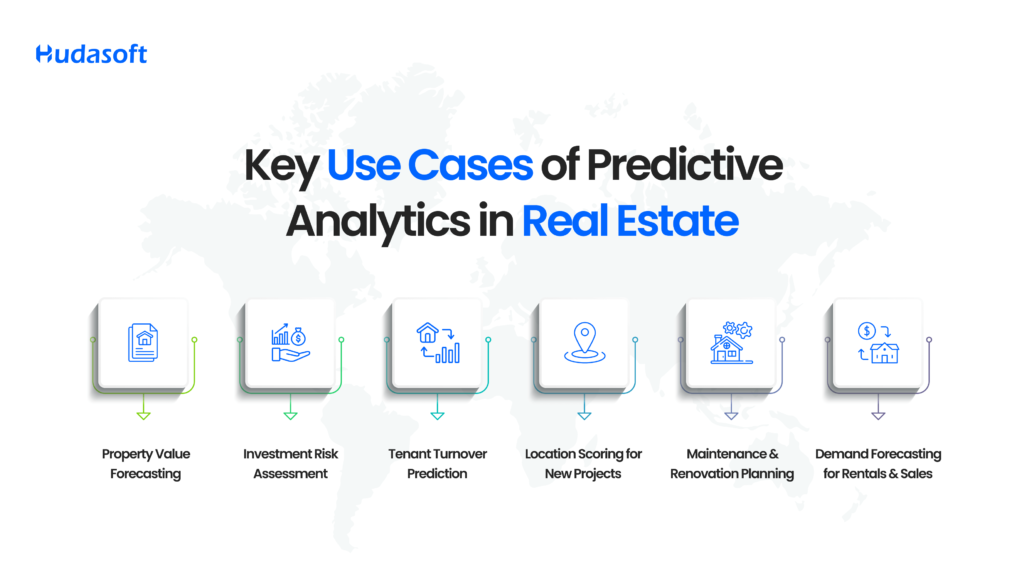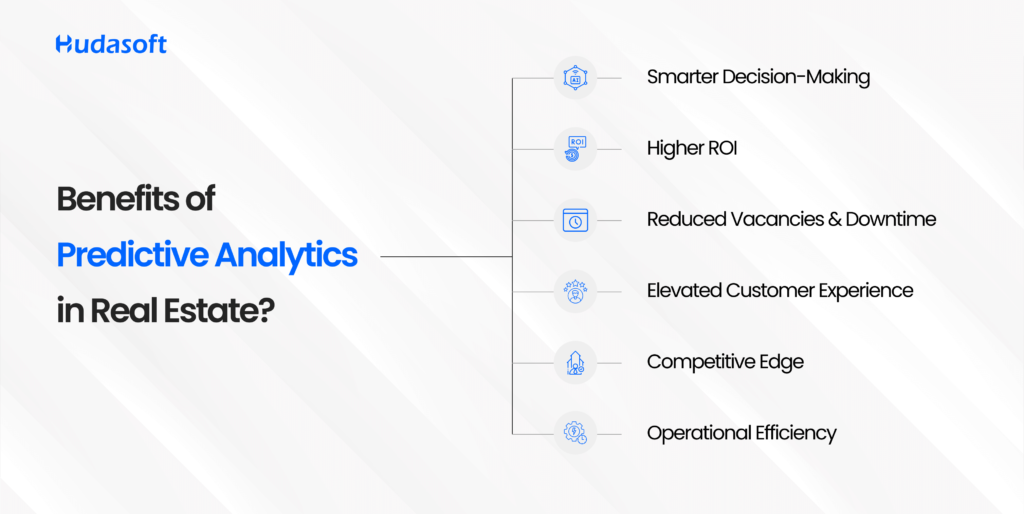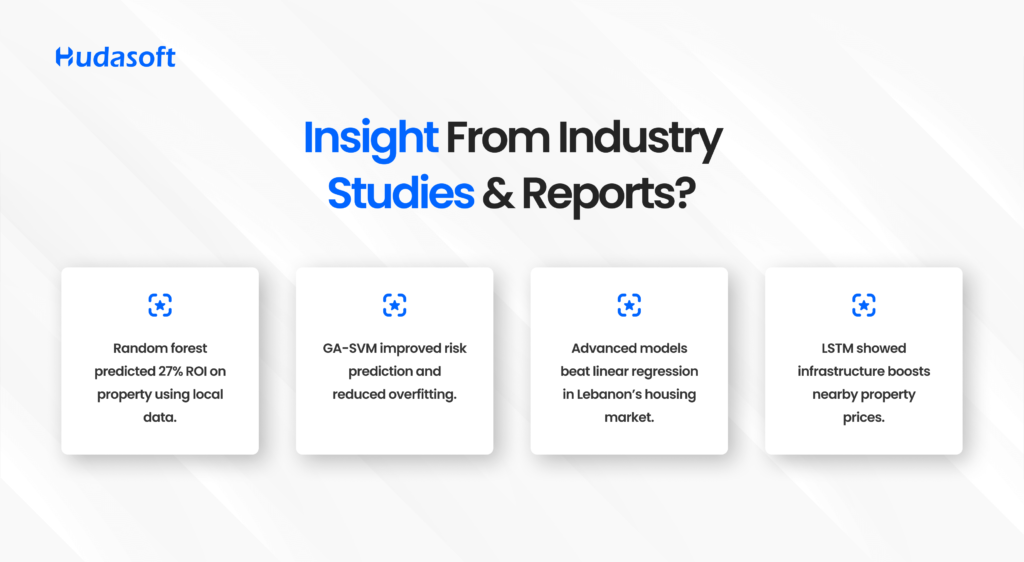In 2023, global residential real estate transactions exceeded $9 trillion—an industry bursting with opportunity, yet far too complex to rely on instinct alone. With shifting tenant behaviors, fluctuating market conditions, and growing data streams, staying ahead now demands more than just experience.
In fact, 87% of real estate leaders believe predictive analytics will significantly shape their business decisions before 2028.
That’s what this blog is all about: how predictive analytics is transforming real estate, from forecasting property value and tenant churn to optimizing lease pricing and reducing vacancies.
And to truly harness this power, off-the-shelf tools aren’t enough.
This is where custom real estate app development becomes essential built around your workflows, data, and strategy to deliver real-time insights and a serious competitive edge. Let’s explore how.
1. What Is Predictive Analytics in Real Estate?
At its core, predictive analytics harnesses historical and real-time data, statistical modeling, and machine learning to forecast future events notably property value, tenant turnover, vacancy rates, lease renewal probability, and demand trends.
According to McKinsey, companies deploying predictive models achieve 8–10 % higher profits and 10–15 % lower costs than their averages. In real estate, where margins can be razor-thin and timing is everything, these gains are transformational.
2. Key Use Cases of Predictive Analytics in Real Estate

A. Property Value Forecasting
Leveraging external variables like neighborhood trends, school quality, and infrastructure changes, models like Zillow’s Zestimate process 7.5 million data points daily to predict valuations across 100 million+ homes.
Custom apps take this further by ingesting your proprietary listing data, comparative sales, and local economic indicators delivering tailored forecasts that help you make smarter buy/sell decisions.
B. Investment Risk Assessment
Risk isn’t only about interest rates. Predictive risk includes property age, crime metrics, natural-disaster zones, and socio-economic shifts. GA‑SVM techniques (Genetic Algorithm‑Support Vector Machine) outperform traditional risk models notably in financial scenarios by offering higher accuracy and lower overfitting.
That means cleaner underwriting and more dependable returns.
C. Tenant Turnover Prediction
A single tenant turnover can cost up to $4,000, factoring in lost rent, marketing, repairs, and administration. Using tenant history, lease terms, and service requests, predictive tools identify “likely-to-leave” tenants well before notice is given, enabling proactive retention programs.
D. Location Scoring for New Projects
From foot-traffic heatmaps to demographic shifts and competitor storefront density, platforms like Placer.ai evaluate thousands of real estate attributes. The result? Quantified, data-driven “location scores” that guide optimal development and leasing decisions.
E. Maintenance & Renovation Planning
IoT sensors coupled with predictive models can lower maintenance expenses by 25 % and extend equipment lifespan by 30 % a conclusion backed by CBRE’s facilities management research. This data-backed approach shifts maintenance from reactive to predictive.
F. Demand Forecasting for Rentals & Sales
CoStar researchers revealed that multifamily demand forecasting reduced inventory mismatches by 18 % in major U.S. metros in 2024. Advanced forecasting enables better market timing, more strategic pricing, and reduced vacancy risk.
3. Benefits of Predictive Analytics in Real Estate

1. Smarter Decision-Making
Leverage hard data not intuition to forecast value, demand, and occupancy trends with confidence.
2. Higher ROI
McKinsey reports that analytics-led investors experienced up to 25 % ROI improvement in acquisitions and asset management .
3. Reduced Vacancies & Downtime
Targeting lease expirations and vacancy risk allows for proactive marketing and new tenant onboarding even before spaces go dark.
4. Elevated Customer Experience
Personalized recommendations (e.g., “This unit is 92 % likely to match you based on…”) and timely interventions (e.g., maintenance, renewal reminders) enhance satisfaction.
5. Competitive Edge
Model-based forecasting trades guesswork for early insights. That means being the first to capitalize on emerging hotspots or raise rents in ascending markets.
6. Operational Efficiency
Automate forecasting, reporting, maintenance alerts, and rent adjustments freeing your team to focus on high-impact strategy and growth.
4. Insight From Industry Studies & Reports

- A GA‑SVM financial risk model improved classification accuracy and reduced overfitting making it a strong candidate for loan underwriting and investor screening systems.
- Comparative evaluations between LSTM, Random Forest, and Stacking Regressors in Lebanon show advanced models outperform linear regression in real-life market contexts.
- A big-data-driven forecasting model analyzed how local infrastructure (like public housing) influences nearby prices using LSTM, aiding urban planning and pricing strategy.
5. ‘Real Estate Analytics Tools’ & ‘Predictive Analytics Tools for Commercial Lease Forecasting’
| Use Case | Top Tool / Method | Output & Insight |
| Property Valuation | Zillow Zestimate, Custom RF models | Accurate value range, +/- margin |
| Lease Price & Expiry | Mashvisor, Reonomy + GA‑SVM | Risk, vacancy, rent trends |
| Investment Scoring | Placer.ai, CoStar Risk Analytics | Location score, risk indicators |
| Tenant Churn Detection | Custom churn models + CRM integration | Probability score + alerts |
| Maintenance Forecasting | IoT + predictive maintenance platforms | Pre-failure alerts |
| Demand Forecasting | CoStar Multifamily Forecasting | Vacancy & demand timeline |
Commercial lease forecasting tools (e.g., CoStar Risk Analytics) blend property characteristics, tenant behavior, and market conditions into forward-looking models essential for long-term planning and portfolio diversification.
6. Why Custom Real Estate Apps Are Essential
Off-the-shelf tools offer broad features, but Custom Real Estate App Development delivers a competitive advantage by aligning technology with your specific property goals and data ecosystem.
Data Integration
Connecting your ERP, CRM, listing databases, MLS feeds, IoT sensors, and external APIs into a unified data lake.
Predictive Engine & Dashboards
Tailored modules for vacancy forecasting, dynamic pricing, tenant risk modeling, and portfolio optimization all powered by ML models trained on your organization’s data.
Real-time Insight, Real-time Action
Forget static reports your tools respond to early warning signs: an at-risk tenant, an underperforming region, or rising vacancy rates. Automated alerts and proactive outreach become the norm.
Scalable, Extensible Architecture
Whether you’re a single-market developer or multi-city property manager, these tools grow with your business ready for new data, models, and features.
7. Unlocking Predictive Analytics Your Seven-Step Roadmap
- Define Goals: Identify your business-critical decisions value estimation, lease forecasting, churn prediction, etc.
- Audit Your Data: Map internal (CRM, listings, tenant) and external (market data, census, financial) sources.
- Choose Models: Match business problems to methods RF for valuation, GA‑SVM for risk, LSTM for demand.
- Train & Validate: Use real historical data with holdout testing to tune model accuracy.
- Integrate: Deploy models within your CRM, dashboards, and workflows for real-time usage.
- Automate: Trigger alerts and actions maintenance orders, tenant offers, rent adjustments—based on predictions.
- Monitor & Iterate: Continuously evaluate accuracy; retrain with fresh data; refine features and user feedback.
Case Study: Qarya – Making Smart Communities Smarter

Challenge:
Property managers using traditional tools struggled with rising tenant churn, delayed maintenance, and unpredictable amenity usage. They had data but no insight.
Solution:
Hudasoft built Qarya with predictive analytics at its core. By analyzing lease patterns, app usage, service requests, and IoT sensor data, Qarya enabled:
- Early detection of tenants likely to leave
- Forecasting amenity demand like gym or pool usage
- Predictive maintenance to prevent equipment breakdowns
Impact:
- 18% increase in lease renewals
- 22% reduction in maintenance issues
- Faster decision-making with real-time dashboards
Qarya shows how predictive analytics turns residential data into proactive action making communities more efficient and resident-friendly through an intelligent property management solution.
Conclusion
Real estate, a trillion-dollar, high-stakes industry demands precision. Predictive analytics transforms your data into foresight:
- Are your acquisitions undervalued or overhyped?
- When is the next vacancy risk coming and who will fill it?
- Where will rent spikes or funding gaps occur and how do you prepare?
Custom real estate apps make these questions actionable translating data into a confident, data-driven strategy.
FAQs
What exactly is predictive analytics in real estate?
Using ML models to process historical and real-time data such as listings, tenant behavior, lease terms, and economics to forecast future outcomes like price changes, occupancy risk, and maintenance needs.
Which “real estate analytics tools” are most effective today?
Top solutions include Zillow Zestimate for valuation, CoStar and Reonomy for market analytics, Placer.ai for location intelligence, Mashvisor for investment scoring, and custom AI models for tailored insights.
Can predictive analytics forecast commercial lease trends?
Absolutely. Tools integrate tenant data, market demand curves, and macro conditions to predict lease expirations, pricing changes, and vacancy timelines enabling strategic lease management.
Why choose custom software over off-the-shelf SaaS?
Custom platforms integrate deeply with your internal systems, offer real-time insight, data automation, tailored analytics, and adapt as your business evolves delivering ROI far beyond generic tools.
What ROI can predictive analytics bring?
Based on studies and industry benchmarks:
• 25 %+ ROI uplift in cluster acquisition and management
• Data‑driven valuation improvements, approx. 10–20 % better pricing accuracy
• Up to 30 % reduction in maintenance costs and equipment downtime
